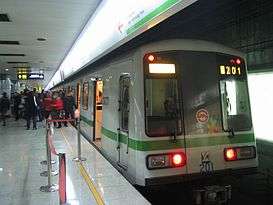Transport in China


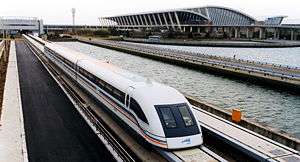
Transport in China has experienced major growth and expansion in recent years. Airports, roads, and railway construction will provide a massive employment boost in China over the next decade.
Railway, which is the primary mode of transport, has also been used for long distances, has doubled in length since the mid-twentieth century, and an extensive network provides service to the entire nation. The larger cities have metro systems in operation, under construction, or in the planning stage. The highway and road system also has gone through rapid expansion, resulting in a rapid increase of motor vehicle use throughout China. Although China's transport system comprises a vast network of transport nodes across its huge territory, the nodes tend to concentrate in the more economically developed coastal areas and inland cities along major rivers.[1]
The physical state and comprehensiveness of China's transport infrastructure tend to vary widely by geography. While remote, rural areas still largely depend on non-mechanized means of transport, a modern maglev train system was built in China to connect the city center of Shanghai with its international airport.
Much of contemporary China's transport systems have been built since the establishment of the People's Republic in 1949. Prior to 1950, there were only 21,800 km (13,546 mi) of railway lines. In 2010, the railway network has since been expanded to 90,000 km (55,923 mi).[2] Rail travel remained the most popular form of transport, although air travel has also experienced significant growth since the late 1990s. The government-led effort — that began in the 1990s — to connect the country by expressways via the "National Trunk Highway System" has expanded the network to about 97,000 km (60,273 mi) by the end of 2012[3] making China's the longest expressway network in the world.
History
China is in the midst of a massive upgrade of its transport infrastructure. Until recently, China's economy was able to continue to grow despite deficiencies in infrastructure development. This is no longer the case, and the Government realizes that to keep the economy moving forward, they need an efficient system in place to move goods and people across the country. According to World Bank statistics, goods lost due to poor or obsolete transport infrastructure amounted to one percent of China's GDP as recently as the most current survey (mid-1990s). Logistic costs account for 20% of a product's price in China, compared to 10% in the United States, and 5% in other developed countries.
Ports are being improved for greater use of China's waterways, and airports are being improved across the country. Related industries such as construction equipment, engineering, container security, and electronics and safety devices have also grown rapidly.
Regulation
Mainland China
Transport in Mainland China is regulated by a new agency formed from the Ministry of Communications, the Ministry of Railways, the Civil Aviation Administration of China.
Special administrative regions
The aforementioned transport authorities have no jurisdiction in Hong Kong and Macau. Hong Kong's transport is regulated by Transport Department of Hong Kong whereas Macau's transport is regulated by Land, Public works and Transport Bureau of Macau.
Rail

Rail is the major mode of transport in China. In 2011 China's railways carried 2,947 billion tonne-kilometers of freight[4] and 961.23 billion passenger-kilometers;[4] both traffic volumes are the highest in the world. The high volume of traffic that China's railway system carries makes it critical to China's economy. China's railway system carries 24% of the world's railway transport volume on only 6% of the world's railways. China has the world's third-largest rail network; as of 2010 it is 91,000 km (56,545 mi) long, an increase of 5,000 km (3,107 mi) of track from 2009. About 47% of the network is electrified. [4]
In 2011 China's railway inventory included 19,431 locomotives[4] owned by the national railway system. The inventory in recent times included some 100 steam locomotives, but the last such locomotive, built in 1999, is now in service as a tourist attraction while the others have been retired from commercial service. The remaining locomotives are either diesel- or electric-powered. Another 352 locomotives are owned by local railroads and 604 operated by joint-venture railways. National railway freight cars numbered 622,284[4] and passenger coaches 52,130 .[4]
Because of its limited capital, overburdened infrastructure, and need to continuously modernize, the national rail system, which is controlled by the Ministry of Railways through a network of regional divisions, operates on an austere budget. Foreign capital investment in the freight sector was allowed beginning in 2003, and international public stock offerings opened in 2006. In another move to better capitalize and reform the rail system, the Ministry of Railways established three public shareholder-owned companies in 2003: China Railways Container Transport Company, China Railway Special Cargo Service Company, and China Railways Parcel Express Company.
In recent decades, rail use in China has seen significant growth in the volume of goods and passengers transported. Since 1980, the volume of goods transported (metric tons times kilometers traveled) has increased by 305% and the volume of passengers (million passengers times kilometers traveled) has increased by 485%.[5] During this same time periond, total Km of rail lines has only increased by 34%.;[5]
| 1980 | 1990 | 2000 | 2010 | 2014 | |
|---|---|---|---|---|---|
| Rail lines (total route-km) | 49,940 | 53,378 | 58,656 | 66,239 | 66,989 |
| Goods transported on railways (metric tons times kilometers traveled) | 570,732 | 1,060,100 | 1,333,606 | 2,451,185 | 2,308,669 |
| Passengers carried on railways (million passengers times kilometers traveled) | 138,037 | 263,530 | 441,468 | 791,158 | 807,065 |
- data from The World Bank & Vizala.com.[5]
Regional development


In 1992, a new large-scale rail project was launched in China, called the "New Silk Road" or "Eurasian Continental Bridge" project. The project involved the modernization and infrastructure development of a 4,131 km (2,567 mi) railroad route starting in Lianyungang, Jiangsu, and traveling through central and northwestern China to Urumqi, Xinjiang, to the Alataw Pass into Kazakhstan. From that point, the railroad links to some 6,800 km (4,225 mi) of routes that end in Rotterdam.
China also has established rail links between seaports and interior export-processing zones. For example, in 2004 Chengdu in Sichuan was linked to the Shenzhen Special Economic Zone in coastal Guangdong; exports clear customs in Chengdu and are shipped twice daily by rail to the seaport at Shenzhen for fast delivery.
Tibet
A 1,080 km (671 mi) section of the Qingzang railway has been completed from Golmud to Lhasa. The 815 km (506 mi) section from Xining to Golmud in Qinghai opened to traffic in 1984. The railway's highest point, the Tanggula Mountain Pass, is 5,072 m above sea level, making it the highest railway in the world. More than 960 km (597 mi), or over four-fifths of the railway, is at an altitude of more than 4,000 m, and over half of it was laid on frozen earth. Because of the high altitudes, carriages are supplied with supplemental oxygen.
Linking Lhasa and Shigatse together in Tibet, the construction of a 254 km (158 mi) extension line of the Qingzang railway started in 2009 with completion expected by 2014.
High-speed rail
.jpg)
The high-speed service is mainly operated by China Railway High-speed. As of October 2010, China has 7,000+ km of rail track capable for 250+ km/h running. Lines capable for 300+ km/h running include:
- Beijing–Tianjin Line, 117 km (73 mi) long
- Wuhan–Guangzhou Line, 968 km (601 mi) long
- Zhengzhou–Xi'an Line, 457 km (284 mi) long
- Shanghai–Nanjing Line, 301 km (187 mi) long
- Shanghai–Hangzhou Line, 160 km (99 mi) long
- Guangzhou–Shenzhen Line, 160 km (99 mi) long
- Beijing–Wuhan Line, 760 km (472 mi) long
- Harbin–Dalian Line, 924 km (574 mi) long
- Shanghai–Beijing Line, 1,380 km (857 mi) long
Maglev train
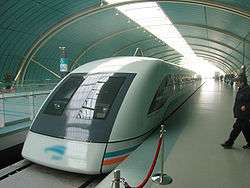
China also has the world's first commercial high-speed maglev (magnetic levitation) train service (the first maglev service opened at Birmingham International Airport, United Kingdom, in 1984; however, it was not high-speed). The Chinese project, a Sino-German joint venture, was a 38-km-long route between downtown Shanghai and the Pudong airport that opened in 2003. The project cost US$1.2 billion.[6]
In 2004 the first Chinese-made maglev train made its debut in Dalian, a major port city in Northeast China's Liaoning Province. The 10.3 km long train has a top speed of just under 110 kilometers per hour. Although the cost to build was high at US$6 million per kilometer, China's outlay was still only one-sixth of the world average.
Railway links with adjoining countries
The only railway link China has with a neighboring country that does not have a break of gauge is with North Korea. China also has links with Kazakhstan, Mongolia and Russia, which all use the 1,520 mm (4 ft 11 27⁄32 in) gauge, and with Vietnam, where the 1,000 mm (3 ft 3 3⁄8 in) gauge is still in use.
China does not have a direct rail link with Afghanistan, Bhutan, India, Kyrgyzstan, Nepal, Pakistan or Tajikistan, but is currently planning links with Laos and India (via Burma).
Variable-gauge-axle trains are sometimes used to overcome the break of gauge with neighboring countries. The mainland is also linked to Hong Kong, but not with Macau, although a Macau link is planned.
Trans-Siberian Railway
The Trans-Siberian Railway, which crosses Russia, has a branch that sweeps down from Ulan-Ude, across Mongolia, and on to Beijing.
Potential link of Qinghai-Tibet railway to India
As India has been extending its railway near the Nathu La pass with China, and China has plans to extend the Qinghai-Tibet railway to near its border with Nathu La, a petition was set up to promote the idea that both countries could link up their respective proportions for direct train services between the two countries. As of 6 September 2011, the petition had 81 members.[7]
Metro
Currently there are 15 rapid transit systems in mainland China. A further 18 systems are under construction and 20 more metros are planned. With the ¥4 trillion economic stimulus package all current existing subway systems are undergoing massive expansion, with many new systems being under construction or planned. The Beijing Subway, which opened in 1969, currently has 15 lines, 218 stations, and 372 km (231 mi) of subway track, and will grow to about 1,000 km (621 mi) by 2020.[8] The Tianjin Metro was begun in 1970 as a planned network of 153.9 km (96 mi) on seven lines, the current existing system contains 2 lines and 26.18 km (16 mi) of track with 22 stations. Shanghai Metro, which opened in 1995, as of the end of 2010 had twelve lines, 233 stations, and 420 km (261 mi) of track in operation, making it the longest metro system in the world. Further expansion plans call for a network of 887 km (551 mi) of track. The Guangzhou Metro, which opened in 1997, has five lines (as of 2010), 144 stations, and has 236 km (147 mi) with an additional 400 km (249 mi) planned to be completed by 2020. The Shenzhen Metro opened in 2004, initially with two lines, 19 stations, and 21.8 km (14 mi) of track;after 2010 it had over 70 km (43 mi), and by June 2011 it had expanded to 177 km (110 mi) of operational metro.
Cities that have a metro system:
- Beijing Subway
- Changsha Metro
- Changchun Light Rail Transit
- Chengdu Metro
- Chongqing Rail Transit
- Dalian Metro
- Dongguan Rail Transit
- FMetro (Foshan)
- Fuzhou Metro
- Guangzhou Metro
- Hangzhou Metro
- Harbin Metro
- Hefei Metro
- Kunming Rail Transit
- Nanchang Rail Transit
- Nanjing Metro
- Ningbo Rail Transit
- Qingdao Metro
- Shanghai Metro
- Shenyang Metro
- Shenzhen Metro
- Suzhou Metro
- Tianjin Metro
- Wuhan Metro
- Wuxi Metro
- Xi'an Metro
- Zhengzhou Metro
Metro systems under construction:
Suburban and commuter rail systems
China's passenger railways are mostly used for medium- and long-distance travel, with few trains stopping anywhere but at major stations in center cities. Commuter rail systems, characteristic of large European and North American cities, are uncommon in China. At the moment, radial suburban metro lines (Shanghai Metro line 9, Binhai Mass Transit, and Guangfo Metro, etc.) are currently filling in this role. However, Beijing Suburban Railway, and some high-speed regional ICLs such as the Guangzhu MRT and Chengdu–Dujiangyan ICL recently started operating.
Metro in the special administrative regions
Hong Kong Mass Transit Railway was planned, designed, constructed and opened under British administration; it was opened in 1979 and merged with the KCR network in 2007 to form a 10-line heavy metro operation and light-rail service.
The Macau LRT was first proposed in 2003, but a final go-ahead was not given until a public announcement by the Government of Macau in October 2006. The Macau Light Transit System will serve the Macau Peninsula, Taipa island, Cotai reclamation area and Macau International Airport.
Road
Motor vehicles

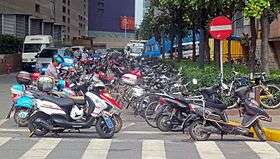
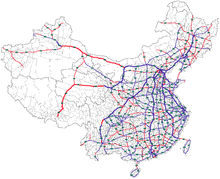
During the war with Japan, in the 1930s, China built many roads, the most famous of which is the Burma Road that leads southwest from Kunming to the city of Lashio. Since it came into power, the Communist government initiated a large effort into building highways that extend across China and beyond its borders.
Today, China is linked by an evolving network of roads (China National Highways) and expressways (Expressways of China). In the past few years, China has been rapidly developing its highway system. Between 1990 and 2003, the total length of urban roads in China more than doubled; increasing from 95,000 to 208,000 kilometers of roads during that period. Similarly, during the same period of time, the total area allocated to roads more than tripled; from 892 million square meters in 1990, to 3,156.5 million square meters in 2003.[9] China National Highways stretch to all four corners of mainland China. Expressways reach the same destinations as China National Highways, except for the rugged terrain of Tibet. An expressway link is already at the planning stage.
In 2005 China had a total road network of more than 3.3 million km, although approximately 1.47 million km of this network are classified as "village roads". Paved roads totaled 770,265 km (478,620 mi) in 2004; the remainder were gravel, improved earth standard, or merely earth tracks.
Highways (totaling 130,000 km) were critical to China's economic growth as it worked to mitigate a poor distribution network and authorities sought to spur economic activity directly. All major cities are expected to be linked with a 108,000 km[10] interprovince expressway system by 2020. The highway and road systems carried nearly 11.6 billion tons of freight and 769.6 trillion passenger/kilometers in 2003.
The importance of highways and motor vehicles, which carry 13.5% of cargo and 49.1% of passengers, was growing rapidly in the mid-2000s. Road usage has increased significantly, as automobiles, including privately owned vehicles, rapidly replace bicycles as the popular vehicle of choice in China. Car ownership is still low in comparison to the other members of the BRIC group of countries, being exceeded by Russia and Brazil.[11] Indeed, the rate of car ownership in China is only expected to meet the 1960s level of car ownership of some developed countries in 2015.[12]
In 2002, excluding military and probably internal security vehicles, there were 12 million passenger cars and buses in operation and 8.1 million other vehicles. In 2003 China reported that 23.8 million vehicles were used for business purposes, including 14.8 million passenger vehicles and 8.5 million trucks. The latest statistics from the Beijing Municipal Statistics Bureau show that Beijing had nearly 1.3 million privately owned cars at the end of 2004 or 11 for each 100 Beijing residents. Beijing currently has the highest annual rate of private car growth in China.
Some 270,000 km (167,770 mi) of rural highways will be built and upgraded in 2008. By comparison, 423,000 km (262,840 mi) of countryside highways were built or upgraded in 2007, a record high. According to China's Transport Ministry, as of the end of 2007, 98.54 percent of villages and towns had already been connected by highways.
The 2008 construction plan comprises five north-south highway trunk roads and seven east-west trunk roads and eight inter-provincial roads. Meanwhile, the central and local governments have continued to allocate funds to support the countryside highway build-up and step up construction quality supervision.[13]
By the end of 2010, China's highways extends 74,000 Kilometers, with the total length of all public roads reaching 3,984,000 km.[14]
Bus rapid transit


More than 30 projects are being implemented or studied in China in some big cities. But few Bus lanes in some cities make it harder to keep the high speed as expected.
- Beijing : 3 lines with 2 branch lines on the way. The busiest, BRT line 1, running on the Nan Zhongzhouxian (South Central Axis Line), launched at the end of December 2005. The line terminates at Qianmen and Demaozhuang, which is 16 km (10 mi) long with 15 intermediate stops.[15] BRT line 4 is under construction.
- Changzhou: 2 lines on the way
- Chongqing: BRT line 1 on the way
- Dalian: Route "BRT Route 1" started operation in 2008
- Guangzhou: BRT line 1 on the way
- Hangzhou: BRT route B1 which started operation on April 22, 2006
- Hefei: 3 lines on the way.
- Jinan: BRT line 1 on the way
- Kunming: System opened in 1999
- Shanghai: A BRT line running between Shanghai West Railway Station and Shanghai West Railway Station is on the way
- Shenyang: More than 6 routes planned.
- Shenzhen: BRT line 1 on the way
- Wuxi : 5 routes planned
- Xiamen : 3 lines on the way
- Xian : 1 East/West route planned
- Zhengzhou: line 1 on the way, linked by 8 BRT branch lines.
Trolleybus systems
As of 2013, trolleybuses provide a portion of the public transit service in 10 Chinese cities.[16] At one time, as many as 27 cities were served by trolleybuses, comprising 28 systems, as Wuhan had two independent trolleybus systems.[17] The Shanghai trolleybus system, which remains in operation, opened in 1914 and is the longest-lived trolleybus system in the world.[17][18] All other trolleybus systems in China opened after 1950.[17]
Town tramway systems
Electrical bicycles

China is the world's leading producer of electric bicycles. According to the data of the China Bicycle Association, a government-chartered industry group, in 2004 China's manufacturers sold 7.5 million electric bicycles nationwide, which was almost twice 2003 sales;[19] domestic sales reached 10 million in 2005, and 16 to 18 million in 2006.[20] By 2007, electric bicycles were thought to make up 10 to 20 percent of all two-wheeled vehicles on the streets of many major cities.[20] A typical unit requires 8 hours to charge the battery, which provides the range of 25–30 miles (40–50 km),[20] at the speed of around 20 km/h (12 mph),[19] however people usually illegal override, makes it just like normal motorcycles, capable of reach nearly 100 km/h (62 mph). A large number of such vehicles is exported from China as well (3 million units, worth 40 billion yuan ($5.8 billion), in 2006 alone),[21]
Bridges
During the infrastructure boom of the past two decades, bridge-building has proceeded at a rapid pace on a vast scale. Notably, prior to the completion of the Wuhan Yangtze River Bridge in 1957, there were no bridges across the Yangtze River, China's longest, from Yibin to Shanghai, and all overland road and railways crossing this 2,884 km (1,792 mi.) stretch of the river required ferries. In 1992, there were only seven such bridges, but by the end of 2012, the tally had reached 73, including eight new openings in that year alone.
Air
As a result of the rapidly expanding civil aviation industry, by 2007 China had around 500 airports of all types and sizes in operation, about 400 of which had paved runways and about 100 of which had runways of 3,047 m or shorter. There also were 35 heliports in 2007, an increasingly used type of facility. With the additional airports came a proliferation of airlines.
Airlines
- Further information: List of airlines of China
The Civil Aviation Administration of China (CAAC), also called the General Administration of Civil Aviation of China, was established as a government agency in 1949 to operate China's commercial air fleet. In 1988 CAAC's operational fleet was transferred to new, semiautonomous airlines and has served since as a regulatory agency.
In 2002 the government merged the nine largest airlines into three regional groups based in Beijing, Shanghai, and Guangzhou, respectively: Air China, China Eastern Airlines, and China Southern Airlines, which operate most of China's external flights.
By 2005 these three had been joined by six other major airlines: Hainan Airlines, Shanghai Airlines, Shandong Airlines, Xiamen Airlines, Shenzhen Airlines, and Sichuan Airlines. Together, these nine airlines had a combined fleet of some 860 aircraft, mostly Boeing from the United States and Airbus from Europe.
To meet growing demands for passenger and cargo capacity, in 2005 these airlines significantly expanded their fleets with orders placed for additional Boeing and Airbus aircraft expected to be delivered by 2010. In June 2006, it was announced that an Airbus A320 assembly plant would be built in the Binhai New Area of Tianjin, with the first aircraft to be delivered in 2008.
Air China owns 17.5% of Cathay Pacific (second largest shareholder) and the Civil Aviation Administration of China (CAAC), an administrative agency of the State Council, owns majority and controlling stakes in China Southern Airlines, China Eastern Airlines, and Air China.
The total number of planes of all mainland Chinese carriers combined will be near 1,580 by 2010, up from 863 in 2006. By 2025, the figure is estimated to be 4,000.[22]
The twenty seven airlines in the Chinese mainland handled 138 million passengers, and 22.17 million tons of cargo in 2005.[22]
Airports
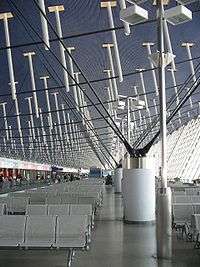
In 2007 China has 467 airports. Of China's major airports, Beijing Capital International Airport (PEK), located 27 km (17 mi) northeast of central Beijing, has the greatest flow of passengers annually.
Shanghai has the 2nd largest amount of air traffic in China through its two airports combined, the Shanghai Pudong International Airport (PVG), which is located 30 km (19 mi) southeast of central Shanghai, and Shanghai Hongqiao International Airport (SHA), which is located 13 km (8 mi) west of central Shanghai. Both are under control of the Shanghai Airport Authority.
The new Guangzhou Baiyun International Airport (CAN), which opened in August 2004 and is located 28 km (17 mi) from downtown Guangzhou.
Other major airports are located at Chengdu, Chongqing, Dalian, Hangzhou, Harbin, Hohhot, Kunming, Qingdao, Shenyang, Tianjin, Urumqi, Xiamen, and Xi'an.
China is served both by numerous major international flights to most countries of the world and a host of domestic regional airlines. Air traffic within mainland China is often connected through Beijing, Shanghai or Guangzhou. They are, respectively, the main hubs for Air China, China Eastern Airlines and China Southern Airlines. In 2003 China's civil aviation sector carried nearly 2.2 million tons of freight and 126.3 trillion passenger/kilometers.
Passenger flights to Taiwan and other places under administration of the Republic of China must follow special rules. Flights between mainland China and Hong Kong International Airport (HKG) and Macao International Airport (MFM) are considered international.
China, however, is planning to build a new airport in Nagqu, Tibet in 2011. It will surpass Qamdo Bangda Airport as being the world's highest airport once completed.[23]
China is also currently in the process of constructing the new Beijing Daxing International Airport, which is scheduled to be completed and operational by 2015. It will become the country's biggest airport with nine runways and it will become the World's busiest airport by international passenger traffic surpassing London-Heathrow and will have more passengers than Atlanta, which is currently the world's busiest airport.[24]
Airports with paved runways
- Total: 403
- Over 3,047 m: 58
- 2,438 to 3,047 m: 128
- 1,524 to 2,437 m: 130
- 914 to 1,523 m: 20
- Under 914 m: 67 (2007)
Airports with unpaved runways
- Total: 64
- Over 3,047 m: 4
- 2,438 to 3,047 m: 4
- 1,524 to 2,437 m: 13
- 914 to 1,523 m: 17
- Under 914 m: 26 (2007)
Ports and shipping
China has more than 2,000 ports, 130 of which are open to foreign ships. The major ports, including river ports accessible by ocean-going ships, are Beihai, Dalian, Dandong, Fuzhou, Guangzhou, Haikou, Hankou, Huangpu, Jiujiang, Lianyungang, Nanjing, Nantong, Ningbo, Qingdao, Qinhuangdao, Rizhao, Sanya, Shanghai, Shantou, Shenzhen, Tianjin, Weihai, Wenzhou, Xiamen, Xingang, Yangzhou, Yantai, and Zhanjiang.
China has sixteen "major" shipping ports with a capacity of over 50 million tons per year. Combined China's total shipping capacity is in excess of 2,890 million tons. By 2010, 35% of the world's shipping is expected to originate from China. The seven largest port terminals are Dalian, Guangzhou, Nanjing, Ningbo, Qingdao, Qinhuangdao, Shanghai. Additionally, Hong Kong is a major international port serving as an important trade center for China. In 2005 Shanghai Port Management Department reported that its Shanghai port became the world's largest cargo port, processing cargo topping 443 million tons and surpassing Singapore's port. The Port of Shanghai is presently undergoing significant upgrades. Shanghai Model Port Alliance is responsible for many of the upgrades that are expected to make Shanghai's port more automated, minimizing the loss of goods and time while helping Customs collect more accurate tariffs. If the Shanghai project is successful, there is interest in replicating the process in other Chinese ports.
As of 2004, China's merchant fleet had 3,497 ships. Of these, 1,700 ships of 1,000 gross register tons (GRT) or more totaled 20.4 million tons. Ships by type: barge carrier 2, bulk carrier 325, cargo ship 840, chemical tanker 21, combination bulk carrier 11, combination ore/oil 1, container ship 125, liquified gas 20, multi-functional large load carrier 5, passenger ship 8, passenger/cargo ship 46, oil tanker 251, refrigerated cargo ship 24, roll-on/roll-off 21, short-sea passenger 43, specialized tanker 2, vehicle carrier 1 (1999 est.)
In 2003 China's major coastal ports handled 2.1 billion tons of freight.
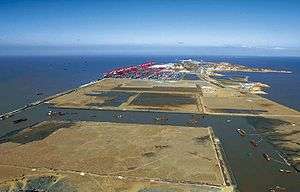
As of 2007, China's merchant fleet had 1,775 ships (1,000 GRT or over) 22,219,786 GRT/33,819,636 tonnes deadweight (DWT) by type: barge carrier 3, bulk carrier 415, cargo ship 689, carrier 3, chemical tanker 62, combination ore/oil 2, container ship 157, liquefied gas 35, passenger 8, passenger/cargo ship 84, oil tanker 250, refrigerated cargo ship 33, roll-on/roll-off 9, specialized tanker 8, vehicle carrier 17.
- foreign-owned: 12 (Ecuador 1, Greece 1, Hong Kong 6, Japan 2, South Korea 1, Norway 1) (2007)
- registered in other countries: 1,366 (Bahamas 9, Bangladesh 1, Belize 107, Bermuda 10, Bolivia 1, Cambodia 166, Cyprus 10, France 5, Georgia 4, Germany 2, Honduras 3, Hong Kong 309, India 1, Indonesia 2, Liberia 32, Malaysia 1, Malta 13, Marshall Islands 3, Mongolia 3, Norway 47, Panama 473, Philippines 2, Sierra Leone 8, Singapore 19, St Vincent and The Grenadines 106, Thailand 1, Turkey 1, Tuvalu 25, unknown 33) (2007)
Two important rail ferry crossings operate off the China coast. The Bohai Train Ferry allows freight trains to shortcut from Liaoning to Shandong, while the Guangdong–Hainan Ferry (part of the Guangdong–Hainan Railway) connects Hainan Island with China's mainland. There are also passenger and vehicle ferry lines connecting China with South Korea and Japan, as well as with the R.O.C.-controlled Kinmen Island.
Waterways
China has 110,000 kilometers of navigable rivers, streams, lakes, and canals, more than any country in the world. In 2015, the traffic on the inland waterways has grown to 3.459 billion tonnes, cargo turnover to 1.331 trillion tkm. It has trebled since 2006. Passenger traffic is 271 million people and 7.308 billion person-km (2015), as reported by the 2015 Transportation Industry Statistical bulletin.[25]

The main navigable rivers are the Heilong Jiang; Yangtze River; Xiang River, a short branch of the Yangtze; Pearl River; Huangpu River; Lijiang River; and Xi Jiang.
Ships of up to 10,000 tons can navigate more than 1,000 km (621 mi) on the Yangtze as far as Wuhan. Ships of 1,000 tons can navigate from Wuhan to Chongqing, another 1,286 km (799 mi) upstream. The Grand Canal is the world's longest canal at 1,794 km (1,115 mi) and serves 17 cities between Beijing and Hangzhou. It links five major rivers: the Haihe, Huai River, Yellow River, Qiantang, and Yangtze.
Construction of new railways and highways has diminished the utility of China's rivers for passenger transport. Nonetheless, passenger boats are still popular in some mountainous regions, such as Western Hubei and Chongqing (the Three Gorges area), where railways are few and road access to many towns is inconvenient.
Pipelines
As of 2006, China had 22,664 km (14,083 mi) of gas pipelines, 15,256 km (9,480 mi) of oil pipelines, and 6,106 km (3,794 mi) for refined products. Due to the growing dependence on oil and gas, the total length of oil and gas pipelines in China has risen to 70,000 km (43,496 mi) from 22,000 km (13,670 mi) in 1997, stretching from oil and gas fields in western and northeastern regions to densely populated coastal areas in the east. By the end of 2010, the network could exceed 90,000 km (55,923 mi).[26]
China's pipelines carried 219.9 million tons of petroleum and natural gas in 2003. As a major oil and gas consumer, China is searching for more external supplies. Construction of a 4,200-km-long pipeline from Xinjiang to Shanghai (West–East Gas Pipeline) was completed in 2004. The government hopes that the use of natural gas will assist to reduce the use of coal which is responsible for much air pollution.
Economic benefits
Some economic experts have argued that the development gap between China and other emerging economies such as Brazil, Argentina and India can be attributed to a large extent to China's early focus on ambitious infrastructure projects, notably mass transport and transit related projects. While China invested roughly 9% of its GDP on infrastructure in the 1990s and 2000s, most emerging economies invested only 2% to 5% of their GDP. This considerable spending gap allowed the Chinese economy to grow at near optimal conditions while many South American economies suffered from various development bottlenecks (poor transportation networks, aging power grids, mediocre schools...).[27]
See also
References
- ↑ Fengbo Zhang:Economic Analysis of Chinese Transportation
- ↑ "China's high-speed railways hit 3,300 km". News.xinhuanet.com. Retrieved 2012-11-07.
- ↑ Chinese highways for fast traffic add up to 65,000 km (40,389 mi) - Chinadaily
- 1 2 3 4 5 6 "Railway Statistical Bulletin for 2011". Ministry of Railway, People's Republic of China. Retrieved February 15, 2012.
- 1 2 3 "China Infrastructure Trends". Vizala.com.
- ↑ Probably the world's fastest train
- ↑ https://www.facebook.com/pages/Petition-for-a-railway-between-China-and-India/112702522143508
- ↑ "北京2020年轨道交通线路预计将达1000公里左右" www.chinanews.com.cn 2010.12.30
- ↑ Wenhua, Wu (2–3 March 2005). Urban travel in China: Continuing challenges with rapid urbanization and motorization (PDF). Workshop on Implementing Sustainable Urban Transport Policies in Japan and other Asia-Pacific countries. Tokyo, Japan. Archived (PDF) from the original on 24 June 2015. cited in Planning and Design for Sustainable Urban Mobility: Global Report on Human Settlements 2013 (PDF) (Revised ed.). United Nations Human Settlements Programme (UN-Habitat). 2014. p. 4. ISBN 978-92-1-132568-3. Retrieved 16 June 2015.
- ↑ F_127 (2011-05-27). "Highway grid to be finished by 2015: MOT - People's Daily Online". English.people.com.cn. Retrieved 2012-11-07.
- ↑ "Transport in Brazil". International Transport Statistics Database. iRAP. Retrieved 2009-02-17.
- ↑ "Transport in China". International Transport Statistics Database. iRAP. Retrieved 2009-02-17.
- ↑ China to add and upgrade 270,000 km (167,770 mi) of rural highway in 2008 - People's Daily Online
- ↑ "China's Highway Network Expands to 74,000 Kilometers". ChinaAutoWeb.com.
- ↑ Gakei.com - Beijing Bus Rapid Transit
- ↑ Webb, Mary (ed.) (2011). Jane's Urban Transport Systems 2011-2012, p. "[23]" (in foreword). Coulsdon, Surrey (UK): Jane's Information Group. ISBN 978-0-7106-2954-8.
- 1 2 3 Murray, Alan (2000). World Trolleybus Encyclopaedia, pp. 8, 57 and 101. UK: Trolleybooks. ISBN 0-904235-18-1.
- ↑ "Shanghai Anniversary" (Nov.-Dec. 2004). Trolleybus Magazine No. 258, pp. 134–135. ISSN 0266-7452.
- 1 2 "China's Cyclists Take Charge", By Peter Fairley. IEEE Spectrum, June 2005
- 1 2 3 "Cheap and green, electric bikes are the rage in China", by Tim Johnson. Originally published 23 May 2007 by McClatchy Newspapers.
- ↑ "Europe's latest craze electric bikes", Associated Press, 14 October 2008. The article gives China Bicycle Association and Xinhua News Agency's "Economic Reference" newspaper, as the sources of the numbers
- 1 2 China's fleet to double in five years
- ↑ Mutzabaugh, Ben. "Mileage calculator". USA Today. Retrieved 2010-05-26.
- ↑ Hatmaker, Taylor (2011-09-15). "China building the world's largest mega-airport near Beijing | Technology News Blog - Yahoo! News". News.yahoo.com. Retrieved 2012-11-07.
- ↑ zizhan.mot.gov.cn/.../t20160506_2024006.html
- ↑ "China discusses draft law on the protection of oil and gas pipelines". 02/11/2009. Retrieved 1 July 2011. Check date values in:
|date=(help) - ↑ M. Nicolas Firzli & Vincent Bazi (Q4 2011). "Infrastructure Investments in an Age of Austerity : The Pension and Sovereign Funds Perspective". Revue Analyse Financière, volume 41. . Retrieved 30 July 2011. Check date values in:
|date=(help)
External links
- Ministry of Transport
- China Transpo run by the Ministry of Transport's Transport Technology Exchange Center
- China Academy of Transportation Sciences (交通部科学研究院) (www.iicc.ac.cn)
- Transportation Information Center (交通信息中心)
- Waterborne Transportation Institute
- China Ports and Harbors Association
- China Sustainable Transportation Center
- China Urban Sustainable Transport Research Center
- Beijing Transportation Research Center
- Shenzhen Research Center of Urban Transportation Planning
- Urban Transport Center, Ministry of Housing and Urban-Rural Development
- National Intelligent Transportation System Engineering Technology Research Center
- Urban Mass Transportation Research
